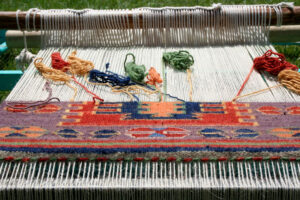

What classes are liberal arts? In the classic tradition, liberal arts classes are interdisciplinary, holistic examinations of a wide range of disciplines. Liberal arts classes are education, history, psychology, and art history. They’re the social sciences – economics, anthropology, political science, media studies; the sciences – biology, neuroscience, environmental science; and the arts – film, theater, studio arts, music and more.
The ages-old tapestry metaphor may very well best describe the liberal arts in general, and the specific classes that make up the curriculum in a liberal arts degree program.
Liberal arts classes are like the interwoven threads of the liberal arts tapestry which, when combined, create a dramatic, sophisticated image of the arts and sciences. This image of an intricately woven tapestry provides us with a better understanding of the liberal arts, where no courses stand alone and nothing isolated.
 Disciplines and fields intermingle here, reflecting and influencing one another. The liberal arts mirror the real world, where nothing exists within a bubble all its own. Disciplines are born out of other disciplines and build upon one another. Through an understanding of one discipline, we gain insight into another.
Disciplines and fields intermingle here, reflecting and influencing one another. The liberal arts mirror the real world, where nothing exists within a bubble all its own. Disciplines are born out of other disciplines and build upon one another. Through an understanding of one discipline, we gain insight into another.
This interconnectedness of disciplines provides us with a worldly view where each thread of the tapestry serves a purpose. Pull at one thread and the tapestry unravels.
How Do Liberal Arts Classes Satisfy the Liberal Arts Mission?
At first glance, classes in the liberal arts don’t look like they have a whole lot in common. But examine them a bit closer and you’ll soon find that when studied as a whole, they lend insight to one another.
Liberal arts courses are those colorful threads that are interwoven – up, down, and around – to create intricate designs. Stand closely to a tapestry and you won’t be able to appreciate – or even distinguish – its design. It’s only when you step back that are you able to fully appreciate the image.
Similarly, liberal arts courses aren’t approached from a narrow perspective. Instead, they involve a broad examination of an area of study—taking a step back to appreciate the bigger picture. It’s this big picture approach that allows students of the liberal arts to better understand how these disciplines are inspired and shaped by one another.
 Anthropology, for example, largely considered the quintessential liberal arts discipline, is influenced and shaped by biology, arts, literature, music, history, economics, politics, geography, and more. For example, a cultural anthropologist studying marriage beliefs in the Middle East must consider everything from political systems to laws to religious rules to economic factors to gender norms. Social movements, religious beliefs, societies, systems of governments – they must all be considered. You simply can’t study this field without also touching on many other areas of study.
Anthropology, for example, largely considered the quintessential liberal arts discipline, is influenced and shaped by biology, arts, literature, music, history, economics, politics, geography, and more. For example, a cultural anthropologist studying marriage beliefs in the Middle East must consider everything from political systems to laws to religious rules to economic factors to gender norms. Social movements, religious beliefs, societies, systems of governments – they must all be considered. You simply can’t study this field without also touching on many other areas of study.
Similarly, you won’t find an artist or author whose work wasn’t influenced by history, society, economics, religion, or politics, so the study of English, literature, and the arts should always be an interdisciplinary endeavor.
Charles Dickins used his fiction to highlight the unjust conditions of English society and inspire debates about moral and social reform… Political unrest and religious convictions influenced Michelangelo’s body of work… And Picasso was a French devotee of communism and an ardent promoter of peace.
When asked about the relationship between art and politics, Picasso once said…
“What do you think an artist is? An imbecile who only has eyes if he's a painter, ears if he's a musician, or a lyre in every chamber of his heart if he's a poet – or even, if he's a boxer, only some muscles? Quite the contrary, he is at the same time a political being constantly alert to the horrifying, passionate or pleasing events in the world, shaping himself completely in their image.”
A study of the liberal arts through interdisciplinary classes provides a holistic examination of ideas across the spectrum —that interwoven tapestry —that produces broad-minded scholars and practitioners who are prepared to understand humankind’s most challenging and complex issues.
Which Classes Are Part of a Liberal Arts Degree? Hint: They’re Rarely the Same from School to School
If you do a side-by-side comparison of liberal arts courses between any two schools, you’re guaranteed to find differences. Though a liberal arts curriculum is always comprised of some blend of arts and humanities, science and social science courses, there is no exhaustive list of liberal arts classes. In fact, liberal arts is defined as much by how course content is examined as what is examined.
Liberal arts classes are grounded in nearly every facet of humanistic inquiry. Can’t get much broader than that. You’ll often hear the terms “depth” and “breadth” to describe the liberal arts because of its holistic, comprehensive approach to study.
Liberal arts courses run the gamut, exposing students to the arts, humanities, social sciences, and natural sciences. Don’t expect a predictable course outline when studying the liberal arts because it doesn’t exist. Course options are extremely diverse and dynamic, often changing from one semester to the next to reflect the issues of the day.
Most schools encourage students to create their own personalized program of study. Many times, this includes choosing a focus, or concentration, in a broad area like the arts, humanities, sciences, social sciences, or human development. But it doesn’t have to be broad at all. You’ll also find very narrowly focused concentrations in unique, highly specialized areas.
General education classes in the liberal arts are a thing of the past. You won’t be blowing through prerequisites before diving into the core of your liberal arts program. Instead, you’ll take courses that support and build on one another. You can’t help but be inspired.
What are Liberal Arts Classes?
You won’t often find any required courses within a liberal arts degree. However, in an effort to create a well-rounded course of study, some schools require that students take a specific number of credits in the humanities, the arts, and in foreign language/culture within their program of study.
Classes in communication (written or oral) and those that satisfy critical thinking (economics, political science, literature, behavioral science, etc.) and diversity of thought (philosophy, religion, art, literature, etc.) may also be a requirement of your liberal arts degree. But, again, there are few hard and fast rules in a liberal arts degree. You’ll be able to meet university course requirements while still designing a program that best meets your career and personal goals.
Electives also play a big part in a liberal arts degree. In many cases, this is where you’ll have the freedom to pick and choose courses that interest you and compliment your chosen focus or concentration.
In short, even among those programs that are more structured, you’ll have plenty of wiggle room to create a program that’s uniquely you. Chances are, your liberal arts degree with a concentration the arts, for example, is going to look different than the same degree and concentration of another student – even within the same school.
For example, pursue a degree in the liberal arts with a concentration in the arts and you’ll have the opportunity to study areas like the studio arts, film, art history, design, and theater and choose electives in areas like political science, history, sociology, and/or psychology.
Courses in a liberal arts degree with a concentration in the arts may include inspiring options such as:
- Love, Sex and Marriage in Renaissance Europe
- Capturing Stories: Smartphone Documentary Filmmaking
- Thelonious Monk and Charles Mingus: The Cutting Edge of Jazz
- Graphic Arts Studio: Studies in Design and Visual Communication
- Poetic Justice: The Role of Poetry and Poets in Shaping Legal Rights
- Experiences in Acting
Or choose a liberal arts degree with a focus in the social sciences and you’ll have the opportunity to study areas like psychology, sociology, political science, and anthropology and choose electives in areas like history, philosophy, and/or religion.
Your coursework may include exciting, thoughtful options such as:
- The Science of the Brain
- The Elements and Tradition of American Dissent
- The Evolution of Government: The Rise of the Modern Nation-State
- Apocalypse and Beyond: Imagining the End of the World from the 1800s to the Present
- Psychiatry: Science, Religion, Oppression, Control
- Positive Psychology Science and Practice: How to Be Happy
- The Human Animal






